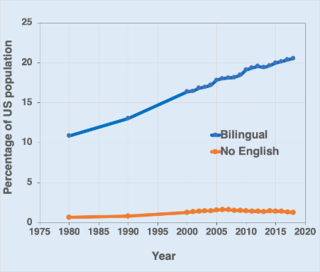Race and Ethnicity
The Amazing Rise of Bilingualism in the United States
The proportion of bilinguals in the U.S. has practically doubled since 1980.
Posted September 11, 2018 Reviewed by Jessica Schrader
This post was updated on April 2, 2020, thanks to new data obtained on that date.
In an earlier post, I described the state of bilingualism in the United States (see here). The U.S. Census Bureau does not keep track of those who use two or more languages in their everyday lives, but since 1980 it does ask three language questions: Does this person speak a language other than English at home? What is this language? How well does this person speak English (very well, well, not well, not at all)? These questions were first asked in the census every 10 years, but are now part of the annual American Community Survey (ACS).
The data that we now have cover 1980, 1990, and every year since 2000 until 2018. Even though children under age five were left out, as were people who use a second or third language in their everyday lives but only English at home, they give us an idea of the number of bilinguals in the US and how the numbers have evolved since 1980.
Researcher Jeffrey Bloem at the University of Minnesota helped me extract the appropriate numbers from the IPUMS database which contains the census and ACS data. For each year, we tabulated those who spoke a language other than English, as well as English to varying degrees (we removed those who did not know English at all as they were not bilingual), and we worked out a percentage based on the total population. I then plotted the results obtained.

As can be seen in the graph on the left (blue function), there is a steady increase of the percentage of bilinguals between 1980 and 2018. Back in 1980, the percentage of bilinguals was 10.68% whereas in 2018, the last ACS survey for which we have data, it was 20.55%, that is 63 million inhabitants. The percentage has practically doubled in 38 years. If we add a few percentage points to take into account those not included in the survey, the proportion of bilinguals today is probably close to 23% of the total population.
Of course, this percentage is still low compared to traditionally multilingual countries (for example, in Switzerland some 42% of the population use two or more languages in everyday life) but similar to that of other countries with a world language as a national language (e.g. France with its 20%).
One will want to study the reasons for this constant rise since 1980. There is, of course, the arrival of new immigrants who learn English and hence become bilingual. Some maintain their languages from generation to generation and hence bilingualism continues. Other reasons may be the (re)learning of some older immigration languages, as well as of Native American languages, and of American Sign language. To these should be added the effort that is being made to allow children and adolescents to acquire and use a second language in the home, as well as more natural language learning opportunities in some schools with immersion and dual language programs.
Some might say that the increasing number of bilinguals goes hand in hand with an increase of inhabitants who know no English. I have plotted the results of those who report that they do not know any English in the same graph (orange function) and, as can be seen, the percentages remain very low throughout all these years. English is so important in the United States that close to 98.7% of the population know it, and use it in everyday life, according to the 2016 ACS results.
Back in 1986, I wrote an op-ed in the Miami News on the state of languages other than English in the United States. I had observed, as had others, the extremely fast shift between two monolingualisms—that of newly arrived immigrants in a non-English language, and that of the great majority of the population in English. I stated, "A national resource—the country's knowledge of the languages of the world—is being wasted and is not being replaced."
I am now happy to observe, more than 30 years later, that an effort is being made to speak and use other languages in addition to English. The position of prominence that English has in the U.S. is in no danger, but some room is now being made for other languages. This can only lead to a person's personal enrichment, increased ties between generations and cultures, and more diversity in job opportunities.
Note: Readers interested in languages other than English in the United States should consult two documents: Karen Zeigler and Steven A. Caramota's analysis of the 2018 ACS Survey (see here) and Camille Ryan's very readable "Language Use in the United States: 2011" (see here). The latter gives details about which non-English languages are spoken at home, English language ability according to languages other than English, age, race and ethnicity, as well as language concentrations in the country.
For a full list of "Life as a bilingual" blog posts by content area, see here.
References
Ryan, Camille. (2013). Language Use in the United States: 2011. American Community Survey Reports, ACS-22. U.S. Census Bureau, Washington, DC.
Ruggles, Steven, Flood, Sarah, Goeken, Ronald, Grover, Josiah, Meyer, Erin, Pacas, Jose, and Sobek, Matthew. IPUMS USA: Version 8.0. Minneapolis, MN: IPUMS, 2018.
Zeigler, Karen, and Camarota, Steven A. (2019). 67.3 Million in the United States Spoke a Foreign Language at Home in 2018. Center for Immigration Studies, Washington, DC.




